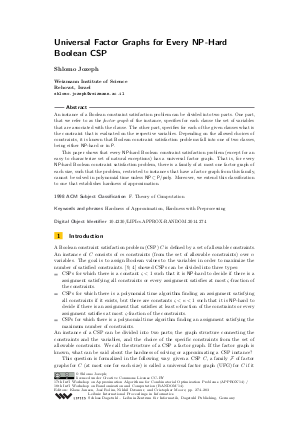Universal Factor Graphs for Every NP-Hard Boolean CSP
Author Shlomo Jozeph
-
Part of:
Volume:
Approximation, Randomization, and Combinatorial Optimization. Algorithms and Techniques (APPROX/RANDOM 2014)
Part of: Series: Leibniz International Proceedings in Informatics (LIPIcs)
Part of: Conference: International Conference on Randomization and Computation (RANDOM)
Part of: Conference: International Conference on Approximation Algorithms for Combinatorial Optimization Problems (APPROX) - License:
 Creative Commons Attribution 3.0 Unported license
Creative Commons Attribution 3.0 Unported license
- Publication Date: 2014-09-04
File

PDF
LIPIcs.APPROX-RANDOM.2014.274.pdf
- Filesize: 371 kB
- 10 pages
Document Identifiers
Subject Classification
Keywords
- Hardness of Approximation
- Hardness with Preprocessing
Metrics
- Access Statistics
-
Total Accesses (updated on a weekly basis)
0PDF Downloads0Metadata Views
Abstract
An instance of a Boolean constraint satisfaction problem can be divided into two parts. One part, that we refer to as the factor graph of the instance, specifies for each clause the set of variables that are associated with the clause. The other part, specifies for each of the given clauses what is the constraint that is evaluated on the respective variables. Depending on the allowed choices of constraints, it is known that Boolean constraint satisfaction problems fall into one of two classes, being either NP-hard or in P. This paper shows that every NP-hard Boolean constraint satisfaction problem (except for an easy to characterize set of natural exceptions) has a universal factor graph. That is, for every NP-hard Boolean constraint satisfaction problem, there is a family of at most one factor graph of each size, such that the problem, restricted to instances that have a factor graph from this family, cannot be solved in polynomial time unless NP is contained in P/poly. Moreover, we extend this classification to one that establishes hardness of approximation.
Cite As Get BibTex
Shlomo Jozeph. Universal Factor Graphs for Every NP-Hard Boolean CSP. In Approximation, Randomization, and Combinatorial Optimization. Algorithms and Techniques (APPROX/RANDOM 2014). Leibniz International Proceedings in Informatics (LIPIcs), Volume 28, pp. 274-283, Schloss Dagstuhl – Leibniz-Zentrum für Informatik (2014)
https://doi.org/10.4230/LIPIcs.APPROX-RANDOM.2014.274
BibTex
@InProceedings{jozeph:LIPIcs.APPROX-RANDOM.2014.274,
author = {Jozeph, Shlomo},
title = {{Universal Factor Graphs for Every NP-Hard Boolean CSP}},
booktitle = {Approximation, Randomization, and Combinatorial Optimization. Algorithms and Techniques (APPROX/RANDOM 2014)},
pages = {274--283},
series = {Leibniz International Proceedings in Informatics (LIPIcs)},
ISBN = {978-3-939897-74-3},
ISSN = {1868-8969},
year = {2014},
volume = {28},
editor = {Jansen, Klaus and Rolim, Jos\'{e} and Devanur, Nikhil R. and Moore, Cristopher},
publisher = {Schloss Dagstuhl -- Leibniz-Zentrum f{\"u}r Informatik},
address = {Dagstuhl, Germany},
URL = {https://drops.dagstuhl.de/entities/document/10.4230/LIPIcs.APPROX-RANDOM.2014.274},
URN = {urn:nbn:de:0030-drops-47021},
doi = {10.4230/LIPIcs.APPROX-RANDOM.2014.274},
annote = {Keywords: Hardness of Approximation, Hardness with Preprocessing}
}
Author Details
References
-
Per Austrin and Johan Håstad. On the usefulness of predicates. TOCT, 5(1):1, 2013.

-
Jehoshua Bruck and Moni Naor. The hardness of decoding linear codes with preprocessing. Information Theory, IEEE Transactions on, 36(2):381 -385, March 1990.

-
Andrei A. Bulatov. On the CSP dichotomy conjecture. In Computer Science – Theory and Applications, volume 6651 of Lecture Notes in Computer Science, pages 331-344. Springer, 2011.

-
Nadia Creignou. A dichotomy theorem for maximum generalized satisfiability problems. J. Comput. Syst. Sci., 51(3):511-522, 1995.

-
Nadia Creignou, Sanjeev Khanna, and Madhu Sudan. Complexity classifications of boolean constraint satisfaction problems. Society for Industrial and Applied Mathematics, 2001.

-
Uriel Feige and Shlomo Jozeph. Universal factor graphs. In ICALP, pages 339-350, 2012.

-
Subhash Khot, Preyas Popat, and Nisheeth K. Vishnoi. 2^log^1-ε n hardness for the closest vector problem with preprocessing. In STOC'12, pages 277-288, 2012.

-
Subhash Khot, Madhur Tulsiani, and Pratik Worah. A characterization of strong approximation resistance. In STOC'14, 2014.

-
Thomas J. Schaefer. The complexity of satisfiability problems. In STOC'78, pages 216-226. ACM, 1978.

-
Luca Trevisan, Gregory B. Sorkin, Madhu Sudan, and David P. Williamson. Gadgets, approximation, and linear programming. SIAM Journal on Computing, 29(6):2074-2097, 2000.

